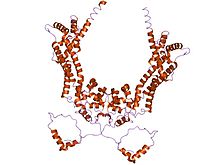 Domain structure of formin proteins across phyla.[1]
Domain structure of formin proteins across phyla.[1]
| DRF Autoregulatory Domain |
|---|
 crystal structure of the n-terminal mdia1 armadillo repeat region and dimerisation domain in complex with the mdia1 autoregulatory domain (dad) |
|
| Symbol | Drf_DAD |
|---|
| Pfam | PF06345 |
|---|
| InterPro | IPR010465 |
|---|
|
Formins (formin homology proteins) are a group of proteins that are involved in the polymerization of actin and associate with the fast-growing end (barbed end) of actin filaments.[2] Most formins are Rho-GTPase effector proteins. Formins regulate the actin and microtubule cytoskeleton
[3][4] and are involved in various cellular functions such as cell polarity, cytokinesis, cell migration and SRF transcriptional activity.[5] Formins are multidomain proteins that interact with diverse signalling molecules and cytoskeletal proteins, although some formins have been assigned functions within the nucleus.
- ^ Chalkia D, Nikolaidis N, Makalowski W, Klein J, Nei M (December 2008). "Origins and evolution of the formin multigene family that is involved in the formation of actin filaments". Molecular Biology and Evolution. 25 (12): 2717–33. doi:10.1093/molbev/msn215. PMC 2721555. PMID 18840602.
- ^ Evangelista M, Zigmond S, Boone C (July 2003). "Formins: signaling effectors for assembly and polarization of actin filaments". Journal of Cell Science. 116 (Pt 13): 2603–11. doi:10.1242/jcs.00611. PMID 12775772.
- ^ Gunning PW, Ghoshdastider U, Whitaker S, Popp D, Robinson RC (June 2015). "The evolution of compositionally and functionally distinct actin filaments". Journal of Cell Science. 128 (11): 2009–19. doi:10.1242/jcs.165563. PMID 25788699.
- ^ Goode BL, Eck MJ (2007). "Mechanism and function of formins in the control of actin assembly". Annual Review of Biochemistry. 76: 593–627. doi:10.1146/annurev.biochem.75.103004.142647. PMID 17373907.
- ^ Faix J, Grosse R (June 2006). "Staying in shape with formins". Developmental Cell. 10 (6): 693–706. doi:10.1016/j.devcel.2006.05.001. PMID 16740473.





